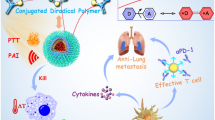Abstract
The dose-response behaviour in total-bladder photodynamic therapy (PDT) is calculated for both the argon-pumped dye laser (630 nm) and the argon laser (488/514.5 nm) wavelengths delivered in two light-delivery methods by using an isotropically emitting fibre placed in the centre of the bladder cavity. Method 1 assumes that the bladder is filled with a perfectly clear medium. In method 2, this is replaced with a perfectly scattering medium. Two assumptions are made: that the bladder is a perfect sphere whose wall thickness is much smaller than its radius, and that there is refractive-index matching between the bladder tissue and the liquid filling the bladder cavity. The optical properties of healthy dog bladder, measured in vitro, are used in the one-parameter diffusion approximation to the radiative transport equation to calculate the distribution of the light fluence rate inside the bladder wall. The integrating-sphere effect of this geometry is explicitly accounted for. Threshold fluences for tumour necrosis are obtained from previous animal experiments. The results confirm that the argon laser provides the method of choice to treat widespread superficial bladder cancer, albeit with a greater risk of damage to the healthy lamina propria. Method 2 predicts better efficiency than method 1, provided that the tumour is superficial. Possible reasons for differences between calculated dose-response curves and clinical results are discussed. The analysis suggests a simple and practical method to assess the clinical dose-response curve from a knowledge of: (a) the local, incident light-dose during (focal) treatment; (b) the resulting depth of PDT-necrosis; and (c) the optical properties of diseased human-bladder tissue.
Similar content being viewed by others
References
Jocham D, Staehler G, Unsold E et al. Dye-laser photoradiation therapy of bladder cancer after photosensitization with hematoporphyrin derivative (HpD)—Basis for an integral irradiation. In: Andreoni A, Cubeddu R (eds)Porphyrins in tumour phototherapy. New York: Plenum, 1984:427–38
Hisazumi H, Miyoshi N, Naito K, Misaki T. Whole bladder wall photoradiation therapy for carcinoma in situ of the bladder: a preliminary report.J Urol 1984,131:884–7
Benson RC. Treatment of diffuse transitional cell carcinoma in situ by whole bladder hematoporphyrin-derivative photodynamic therapy.J Urol 1985,134:675–8
Nseyo UO, Dougherty TJ, Boyle DG et al. Whole bladder photodynamic therapy for transitional cell carcinoma of bladder.Urology 1985,26:274–80
Jocham D, Staehler G, Baumgartner R, Unsold E. Die integrale photodynamische Therapie beim multifokalen Blasenkarzinom: Erste Klinische Erfahrungen.Urol Ausg A 1985,24:316–9
Hisazumi H, Misaki T, Miyoshi N. Photoradiation therapy of bladder tumors.J Urol 1983,130:685–7
Benson RC, Kinsey JH, Cortese DA et al. Treatment of transitional cell carcinoma of the bladder with hematoporphyrin derivative phototherapy.J Urol 1983,130:1090–5
Tsuchiya A, Obara N, Miwa M et al. Hematoporphyrin derivative and laser photoradiation in the diagnosis and treatment of bladder cancer.J Urol 1983,130:79–82
Hofstetter A, Frank F, Keiditsch K, Bowering R. Endoscopic Neodymium-YAG laser in destroying bladder tumors.Eur Urol 1981,7:278–82
Smith JA, Dixon JA. Laser photoradiation in urologic surgery.J Urol 1984,131:631–5
Bellnier DA, Lin CW, Prout GR. Treatment of bladder carcinoma with 514 nm light plus HpD: an approach to whole bladder photoradiation therapy.J Urol 1984,131:110A
Van Gemert MJC, Berenbaum MC, Gijsbers GHM. Wavelength and light-dose dependence in tumour phototherapy with haematoporphyrin derivative.Br J Cancer 1985,52:43–9
Van Gemert MJC, Welch AJ, Star WM et al. Tissue optics for a slab geometry in the diffusion approximation.Lasers Med Sci 1987,2:295–302
Ishimaru A.Wave propagation and scattering in random media, vol 1: Single scattering and transport theory. New York: Academic Press, 1978
Marijnissen JPA, Star WM. Phantom measurements for light dosimetry using isotropic and small aperture detectors. In: Doiron DR, Gomer CJ (eds)Porphyrin localization and treatment of tumors. New York: Alan Liss, 1984:133–48
Van Gemert MJC, Verdaasdonk R, Stassen EG et al. Optical properties of human blood vessel wall and plaque.Lasers Surg Med 1985,5:235–7
Star WM, Marijnissen JPA, van den Berg-Blok AE et al. Destruction of rat mammary tumor and normal tissue microcirculation by hematoporphyrin derivative photoradiation observed in vivo in sandwich observation chambers.Cancer Res 1986,46:2532–40
Doiron DR, Svaasand LO, Profio AE. Light dosimetry in tissue: application to photoradiation therapy.Adv Exp Med Biol 1983,160:63–76
Star WM, Marijnissen JPA, Jansen H et al. Light dosimetry for photodynamic therapy by whole bladder wall irradiation.Photochem Photobiol: in press
Author information
Authors and Affiliations
Rights and permissions
About this article
Cite this article
Van Gemert, M.J.C., Cheong, WF., Welch, A.J. et al. Light delivery for whole-bladder photodynamic therapy. Laser Med Sci 2, 273–284 (1987). https://doi.org/10.1007/BF02594172
Received:
Issue Date:
DOI: https://doi.org/10.1007/BF02594172




